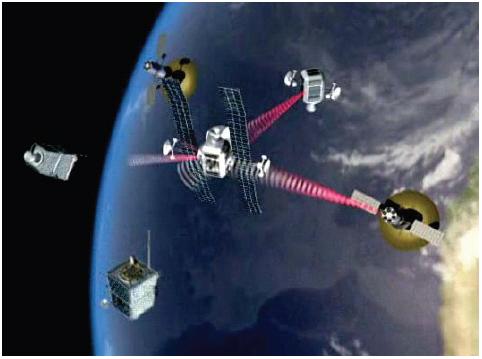DIY Friday: Spacecraft
Friday, February 29th, 2008
So, you’re sitting at your desk thinking about the sci-fi movie you watched last night or a fantasy outerspace adventure. If you can’t wait for the weekend to make your futuristic dreams a reality (sort-of), start by building an Office Supplies Starship Enterprise. From your employer’s supply cabinet, grab one wall clip, two small paperclips, one large paperclip, one small pinch clip, some tape, and a black Sharpie. With a little ingenuity, you have a passable replica for some afternoon day-dreaming.
Now, for tomorrow’s task – build a cardboard spaceship out of two washer/dryer boxes. With a little paint it sure can look good — too bad it can’t fly.

Alfie Carrington, a construction worker from Michigan is a little more ambitious:
The construction worker spends his free time inside a rented storage garage in Clinton Township, Mich., where he broods over a 14-foot-wide, carbon fiber, fiberglass vessel.
Thirty years ago, when Carrington was 27 and obsessed with science fiction, he set out to build a UFO look-alike. Despite his lack of engineering experience, Carrington pored over books, magazines and studies about aviation and spent nearly $60,000 for some of the materials needed for this saucer.
Carrington does it because he believes he has discovered a simple design for an aircraft that aeronautical engineers have spent countless millions trying to build.
Carrington has two patents on the design and a company called Vertex Aerospace. His work caught the attention of NASA, which invited him to a conference in the mid-1990s where engineers scratched their heads when he confessed he knew nothing about computers.
His own version of Anti Gravity Technology Propulsion: His idea is to fire up the vessel with a rotary engine to stimulate a magnetic levitation system to rotate the ship’s two discs. The discs would draw air into propeller blades.
A (very entertaining) video of the project is below. But before you take up a similar design, a word of warning:
“Things spinning at those speeds are worrisome because of the stress from centrifugal force,” explained Cornelis van Dam, professor of mechanical and aeronautical engineering at the University of California-Davis, a leading aviation school. “If it’s not properly designed and built, it will rip itself apart. I wouldn’t want to stand next to it when it gets up to speed.”

If you’re a little timid about centrifugal destruction, maybe we should keep the saucer on the ground. For the kids, build a saucer fort built from two discarded microwave transmitter dishes and $75 bucks worth of supplies. And if you want more than a little tree-house, you should buy this house in Tennessee. You can see it from space:
If the static house isn’t good enough and you’re still scared of Alfie’s saucer, buy an individual flying vehicle for a pricey 50k. Or, better yet, just fake it:









